Abstract
This review describes recent advances in copper-catalyzed difluoroalkylation reactions. The RCF2 radical is generally proposed in the mechanism of these reactions. At present, various types of copper-catalyzed difluoroalkylation reactions have been realized. According to their characteristics, we classify these difluoroalkylation reactions into three types.
1. Introduction
Difluorinated compounds such as fludioxonil [1], gemcitabine [2] and maraviroc [3] play an important role in the agrochemical, pharmaceutical, and materials science industries due to their special physical and chemical properties (Figure 1) [4,5,6]. As a consequence, more and more attention has been paid to the development of simple and efficient methods for introducing difluoroalkyl groups in recent years. Transition-metal-catalyzed difluoroalkylation via cross-coupling is an efficient and attractive method for this reaction. Various catalysts (Pd, [7] Ir, [8,9] Cu [10], Ni [11], etc. [12,13]) have been successfully applied in difluoroalkylation reactions [14,15,16,17,18,19]. However, it is still a great challenge to selectively control the catalytic cycle and obtain the desired fluorinated compounds by directly using classical transition-metal-catalyzed cross-coupling reactions, as some difluoroalkyl metal species have significantly different properties from their nonfluorinated analogues. They are unstable and can easily protonate, dimerize, and/or produce other unknown byproducts. Compared with other metal catalysts, copper has the advantages of low cost, low toxicity, wide availability, etc. Accordingly, copper-catalyzed reactions have seen much progress [20,21,22,23,24,25,26,27,28,29,30]. As early as 1986, a copper-mediated Ullmann cross-coupling reaction of halodifluoroacetates with activated (hetero)aryl electrophiles was reported by the Kobayashi group [10]. However, excess copper was required in this system. With regard to copper-catalyzed difluoroalkylation reactions, there have been several reports in recent years. In this review, the progress of difluoroalkylation in the last 3 years is summarized. According to their differences, these difluoroalkylation reactions were classified into three types (Figure 2).

Figure 1.
Difluoroalkylated drugs or candidates.
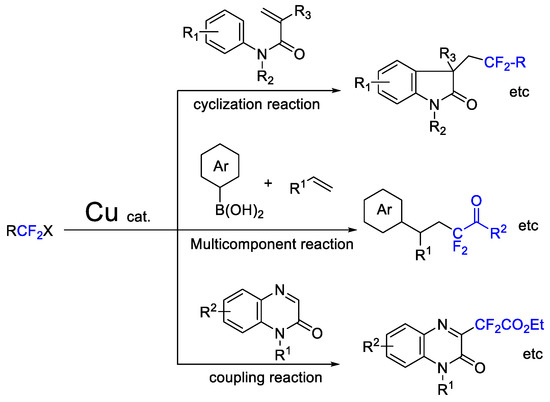
Figure 2.
Copper-catalyzed difluoroalkylation reactions.
2. Difluoroalkylation–Cyclization Reactions
Jiang’s group reported the copper-mediated difluoromethylenation between N-arylacrylamides and benzo-1,3-oxazolic difluoromethylbromide (Scheme 1) [31]. Control experiments were conducted, implying that a radical intermediate was possibly involved in this transformation. RCF2 radicals, which were generated from the Cu(0)-mediated single-electron transformation with RCF2Br, could be added to the terminal end of the C=C double bond of N-arylacrylamide. Subsequently, an intramolecular radical cyclization reaction occurred to form the final product.
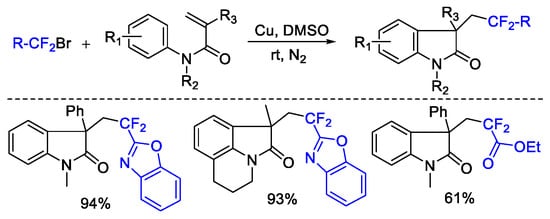
Scheme 1.
The copper-catalyzed difluoromethylenation of N-arylacrylamides.
In 2018, Shi’s group established a facile method to construct diverse difluorinated quinoline-2,4-diones via the Cu-catalyzed direct difluoromethylation of activated alkenes. A difluoromethyl radical addition/cyclization reaction mechanism was indicated for this strategy (Scheme 2) [32]. It is worth noting that this reaction could also be carried out in the presence of a visible-light photo-redox catalysis.

Scheme 2.
Difluorinated quinoline-2,4-diones catalyzed by copper.
The copper/B2pin2-mediated difluoroalkylation of methylenecyclopropanes with bromodifluorinated acetates and acetamides was illustrated by Wang and coworkers (Scheme 3) [33]. Various substrates reacted smoothly in this reaction system. Both the catalyst and an inert atmosphere are necessary for the successful operation of the reaction. A Cu(II)/Cu(I) catalyzed tandem radical process, which involved ring-opening/intramolecular cyclization, was proposed in the reaction mechanism.
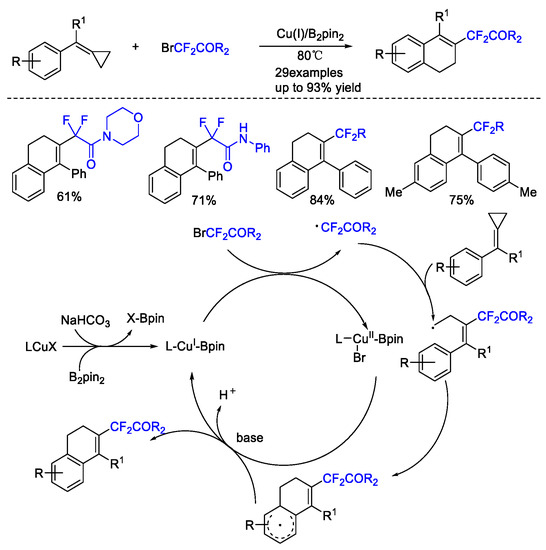
Scheme 3.
The copper/B2pin2-catalyzed difluoroalkylation of methylenecyclopropanes.
Difluoroacyl heterocyclic compounds are widely found in various bioactive compounds and agricultural chemicals [34,35]. At present, these reactions have been studied extensively [36,37]. In 2019, Wu’s group realized the copper-mediated free-radical cyclization of naphthalenyl iododifluoromethyl ketones with olefins (Scheme 4) [38]. The corresponding difluoroacyl compounds with moderate yields were obtained. Mechanistic investigations suggested that difluorinated radical intermediates, which were generated from the reduction reaction of RCF2I with Cu(0), were involved in the reaction pathway.
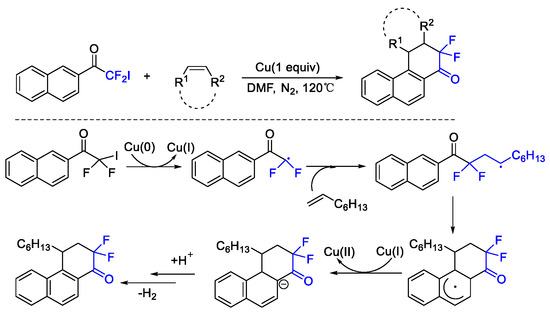
Scheme 4.
The copper-mediated radical cyclization of naphthalenyl iododifluoromethyl ketones.
Wang’s group reported, for the first time, the difunctionalization of unactivated alkenes through desulfonylation-initiated distal alkenyl migration. Using this method, previously unknown 3,3-difluoro-5-styrylpiperidin-2-one derivatives with a quaternary stereocenter can be efficiently constructed (Scheme 5) [39]. A radical mechanism was involved in this reaction. Initially, a single-electron transfer process occurs between the Cu(I) species and BrCF2R3 to generate fluoroalkyl radical 5a and Cu(II) species. The less steric terminal olefin is then selectively attacked by fluoroalkyl radical 5a, yielding a transient alkyl radical 5b. Radical 5b reacts with the internal double bond to form cyclized radical 5c. Then, radical 5c undergoes the desulfonylation reaction, forming the critical N-center radical 5d. Finally, the 3, 3-difluoro-5-pyranopridine-2-ketone product was produced via the cyclization reaction.
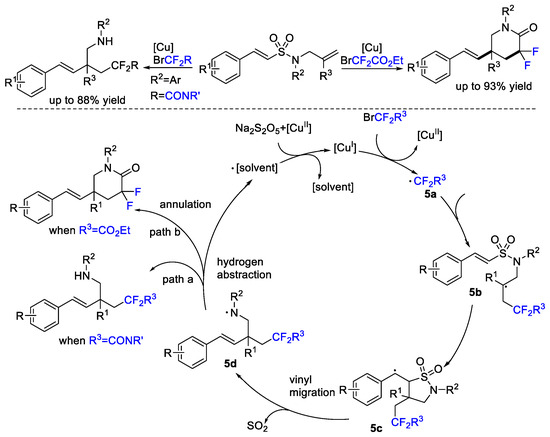
Scheme 5.
The difunctionalization of unactivated alkenes through desulfonylation.
Song’s group developed an effective method for the synthesis of 3,3-difluoro-2- oxindoles by copper/B2pin2-catalyzed C-H difluoroacetylation–cycloamidation of aniline with ethyl bromodifluoroacetate. (Scheme 6) [40]. In this strategy, amino groups act as directing groups to regioselectively provide ortho-difluoroacetylated products. In the presence of a base, LCu(I)-Bpin species 6a was formed by the reaction of LCuX(I) and B2pin2. Then, species 6a reduced BrCF2CO2R to form the CF2CO2R radical. Subsequently, the CF2CO2R radical reacted with aniline to produce an amino-oriented intermediate 6c. Finally, the desired products, 3,3-difluoro-2- oxindole derivatives, were isolated via the SET pathway and an intermolecular cycloamidation reaction of ester with the amino group.
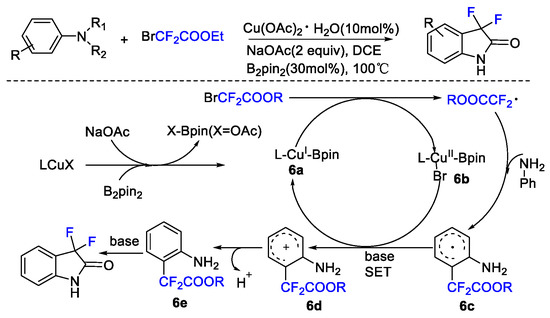
Scheme 6.
The copper/B2pin2-catalyzed C–H difluoroacetylation–cycloamidation of anilines.
The difluoromethylation reaction using aryl-substituted anilines as substrates is challenging due to the steric disadvantage, as well as due to entropy. The C–H [3 + 2] annulation of N-aryl or alkyl-substituted anilines with bromodifluoroacetate catalyzed by copper was realized by Li’s group (Scheme 7) [41]. The corresponding products, 3,3′-disubstituted oxindoles, can be obtained with moderate to good yields.

Scheme 7.
The copper-catalyzed annulation of N-substituted anilines.
Difluoroalkylation of an olefin/nitrile insertion/cyclization tandem sequence of N-cyanamide olefins catalyzed by copper was realized by Liao’s group, which provides a convenient synthesis method for obtaining difluorobicycloamides containing imine groups in a sustainable manner (Scheme 8) [42]. The protocol has the advantages of a high yield, wide substrate range and good functional group compatibility. In addition, diverse synthetic transformations have also been demonstrated for preparing various functionalized difluorinated aza-heterocycles.
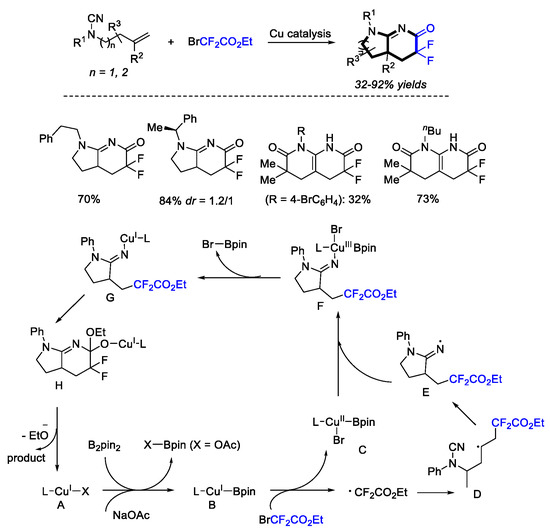
Scheme 8.
The difluoroalkylation of an olefin/nitrile insertion/cyclization catalyzed by copper.
In recent years, the cyclization reaction of alkenyl carboxylic acids with difluoroalkyl reagents has been established for the synthesis of difluoroalkyl lactones. In 2018, Li’s group achieved difluoroalkylation of alkenyl carboxylic acids catalyzed by a copper catalyst under mild reaction conditions (Scheme 9) [43]. The high-value lactones were delivered containing CF2 with moderate to excellent yields. A catalytic reaction pathway involving free radicals was proposed. Firstly, the RCF2 radical and Cu(II) species were generated from an initial single-electron transfer (SET) from Cu(I)Ln 9a to RCF2Br. Subsequently, the difluoroalkyl radical intermediate 9b was obtained from the addition reaction of the RCF2 radical with unsaturated carboxylic acid. Then, 9b was oxidized by Cu(II) to give the carbocation intermediate 9c, and the copper(I) catalyst was regenerated. Finally, an intramolecular nucleophilic attack reaction could provide the final product (Scheme 36, path a). Another pathway that forms the final product under basic conditions through the reductive elimination of Cu(III) intermediate 9d is also possible (Scheme 9, path b). Another copper-catalyzed difluoroalkylation between alkenyl carboxylic acids and BrCF2R reagents for the synthesis of lactone was also demonstrated by Wang and coworkers (Scheme 10) [44]. A similar reaction mechanism which contains a Cu(I)/Cu(II) cycle was suggested for this transformation.
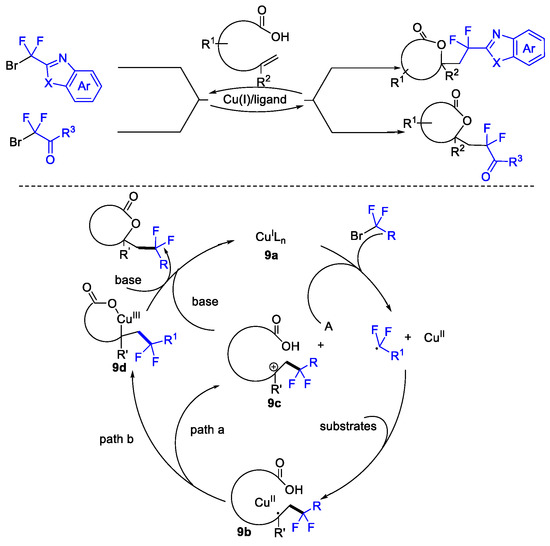
Scheme 9.
The cyclization between alkenyl carboxylic acids and difluoroalkyl reagents.
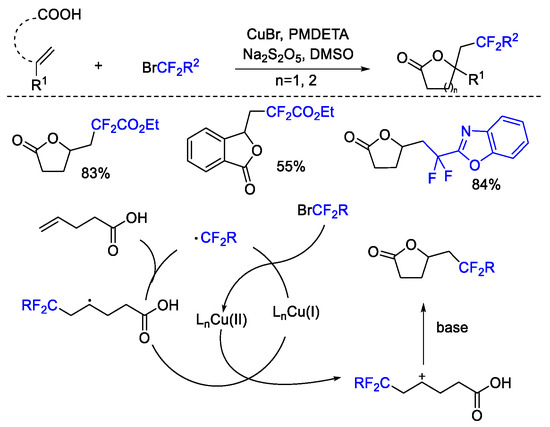
Scheme 10.
The copper-catalyzed cyclization of unsaturated carboxylic acids.
Wang and Guo’s group established a copper-catalyzed intramolecular oxydifluoroalkylation of hydroxyl-containing alkenes and various fluoroalkylated tetrahydrofurans observed in this reaction [45]. In addition to ethyl bromodifluoroacetate, other functionalized difluoroalkylated bromides also reacted smoothly in this system. The reaction mechanism is depicted in Scheme 11. First, the oxidation between Cu(I) and ethyl bromodifluoroacetate occurred to produce the RCF2 radical 11a and Cu(II) intermediate. Intermediate 11b could be formed via the addition reaction between radical 11a and alkenes, which was captured by the Cu(II) species with the help of the Na2CO3 base to form intermediate 11c. Then, two possible intermediates, 11d or 11e, can be formed. Intermediate 11d can undergo an activated-alcohol nucleophilic attack on carbon cation species and generate the desired product. Alternatively, reductive elimination of intermediate 11e can also provide the final product. Both of the two pathways are possible at the moment. In 2019, this group demonstrated that a variety of difluorinated nitrogen-containing polycyclic compounds can be obtained when amine-containing olefins are used instead of hydroxy-containing olefins as substrates (Scheme 12) [46]. The electrophilic RCF2 radical and Cu(II) intermediates produced from the oxidation of Cu(I) species by BrCF2CO2Et via single-electron transfer (SET) were also described in a possible reaction mechanism. Recently, Luo’s group also realized the photoredox-induced oxydifluoroalkylative cyclization of alkenes using RfI as substrates [47].
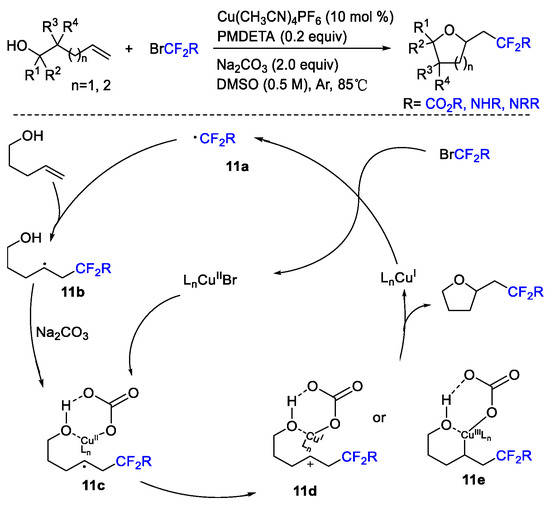
Scheme 11.
The intramolecular oxydifluoroalkylation of hydroxyl-containing alkenes catalyzed by copper.

Scheme 12.
The copper-catalyzed reaction for synthesis of difluorinated polycycles.
Copper-catalyzed redox cycloisomerization between non-prefunctionalized nitroalkynes and BrCF2CO2Et for the synthesis of C2-tetrasubstituted indolin-3-ones was achieved by Song’s group (Scheme 13) [48]. Using diboron as the reducing reagent, this reaction can be carried out using a one-pot protocol, and a fluorine-containing noncarbon quaternary center can be constructed. The author conducted the experiment for mechanism research. The results showed that B2pin2 captures an oxygen in NO2 with the help of Na2CO3. The other oxygen in NO2 was converted into a C=O bond of C2-tetrasubstituted indolin-3-ones.

Scheme 13.
The copper-catalyzed redox cycloisomerization.
Shi’s group described the cyclization reaction of vinyl isocyanides with bromodifluoroacetic derivatives promoted by the Cu/B2pin2 system, and various 1-difluoroalkylated isoquinolines were generated (Scheme 14) [49]. Preliminary mechanistic studies were conducted and the results implied that a tandem radical cyclization process was possible for this reaction. In addition, visible light could also promote this transformation efficiently.
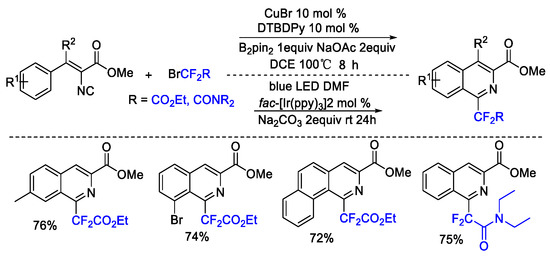
Scheme 14.
The Cu/B2pin2-promoted cascade cyclization of vinyl isocyanides.
In 2018, BrCF2CO2Et was discovered by Song’s research group to play a dual role as a difluoroalkylation reagent and C1 synthon in the reaction of BrCF2CO2Et with a primary amine (Scheme 15) [50]. BrCF2CO2Et reacts with Na2CO3 through decarboxylation and debromination to form difluorocarbene, which can participate in the catalytic cycle. Based on DFT calculations and experimental observations, they found that the base plays an important role in the reaction of primary amines and difluorocarbene to form the key intermediate isocyanides.
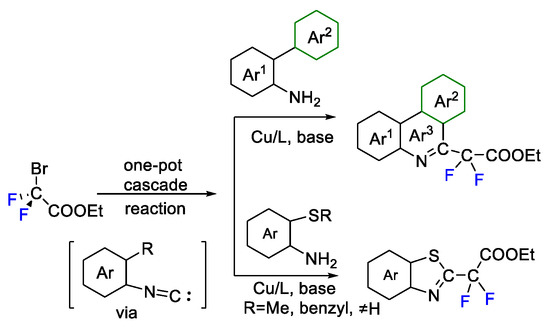
Scheme 15.
The reaction of BrCF2COOEt with primary amines.
The copper-catalyzed oxydifluoroalkylation of β, γ-unsaturated oximes was studied by Wang and coworkers (Scheme 16) [51]. A Cu(III)/Cu(I) catalytic cycle was described for this transformation. The reaction proceeds through a difluoroalkylation cascade of olefins, followed by a nucleophilic reaction of the hydroxyl group of the oxime. This method has the advantages of mild reaction conditions, low catalyst cost and wide substrate range, which makes it a simple method for the preparation of the fluorine-containing side-chain isoxazoline.
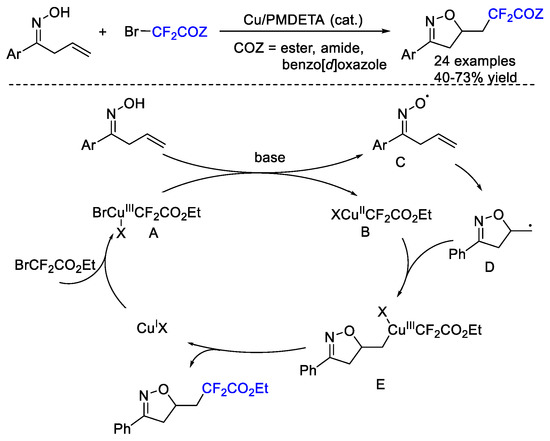
Scheme 16.
The oxydifluoroalkylation of unsaturated oximes.
Zhu’s group reported on the copper-catalyzed bromodifluoroacetylation cyclization reaction (Scheme 17) [52]. The treatment of bromodifluoroacetic acid derivatives with Cu(I) and B2Pin2 can generate difluoroalkyl radicals and trigger radical addition/cyclization/bromination sequences. Bromodifluoroacetyl-derived esters, amides, and ketones are well compatible in this system, generating various vinyl C–bromine bonds containing functionalized heterocycles with high yields. Two possible alternative bromination processes are proposed for the C-Br bond formation step in the vinyl intermediate: a possible radical chain-reaction mechanism and an organic metal Cu(III)/Cu(I) process.
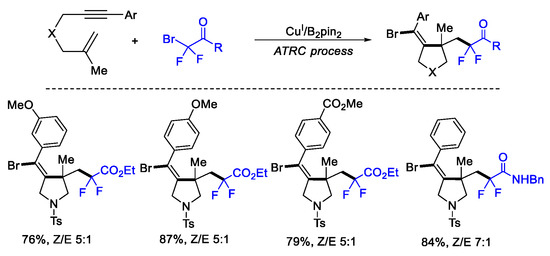
Scheme 17.
The copper-catalyzed bromodifluoroacetylation cyclization reaction.
Zhu’s group was the first to achieve the copper-catalyzed cascade radical addition/dearomative spirocyclization of biaryl ynones for the preparation of difluoromethylated spiro [5.5] trienones (Scheme 18) [53]. A series of spiro compounds can be constructed via this reaction. Monofluoromethylated and phosphorated spiro [5.5] trienones were also produced when diethylphosphite was used as a substrate in the presence of Ag as a catalyst. A fluoroalkyl radical was generated in the reaction catalytic cycle. The addition of the RCF2 radical to the C-C triple bond of 18a produced the vinyl radical 18b, which was followed by 6-exo-trig cyclization forming intermediate 18c, and the oxidation reaction of 18c by Mn+1 could produce oxocarbenium ion 18d. Finally, the desired product was formed via a demethylation reaction.
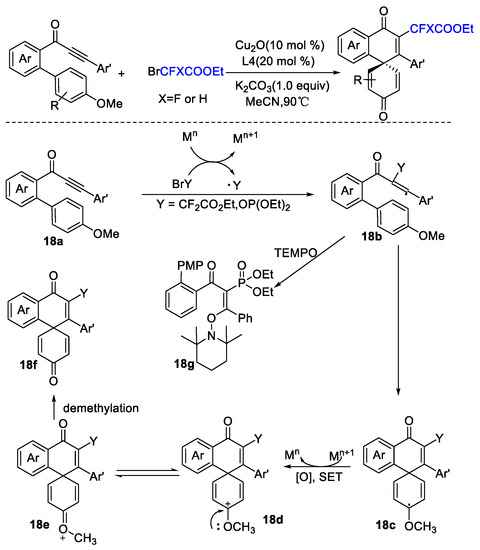
Scheme 18.
The copper-catalyzed spirocyclization of biaryl ynones.
An effective method for the preparation of difluoroalkyl 2-azaspiro [4.5] decane by copper-catalyzed difluoroalkylation of N-benzylacrylamide with ethyl bromodifluoroacetate was developed by Han’s group (Scheme 19) [54]. The difluoroalkylation of substituted N-benzylacrylamides, 5-exo cyclization, and dearomatization reactions were suggested in the cascade reaction. In addition, the obtained product can be successfully converted into saturated spirocyclohexanone scaffolds and difluoroalkyl quinolinone.
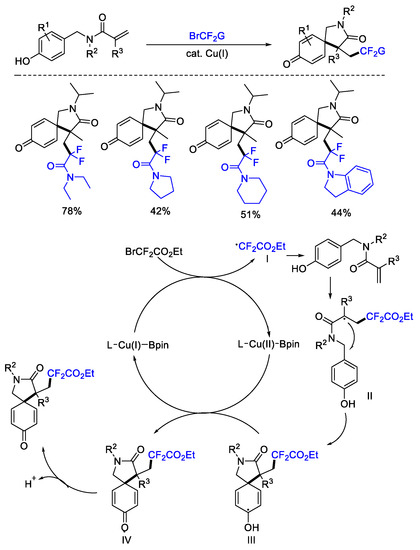
Scheme 19.
The synthesis of difluoroalkyl 2-azaspiro [4.5] decane.
3. Difluoroalkylation–Multicomponent Reactions
Alkenes were found to react well with fluoroalkyl halides and boronic acids, and the γ-arylation of carbonyl compounds can be realized via these reactions. Shu and coworkers found that the copper and visible-light catalysis plays an important role in this reaction [55]. The reaction mechanism is described in Scheme 20. The oxidative quenching reaction between the excited Ir*(III) photocatalyst and BrCF2CO2Et occurred to form radical intermediate 20a and the oxidized photocatalyst Ir(IV). Then, the addition reaction of 20a and alkenes could provide a new alkyl radical intermediate 20b. With the help of a base, the reaction between Cu(I) and aryl boronic acid occurred to form the arylcopper intermediate 20c, which could be converted to 20d via recombination with 20b. Then, the final product was generated from 20d via reductive elimination, with the concurrent liberation of Cu(I) and Ir(III) species.
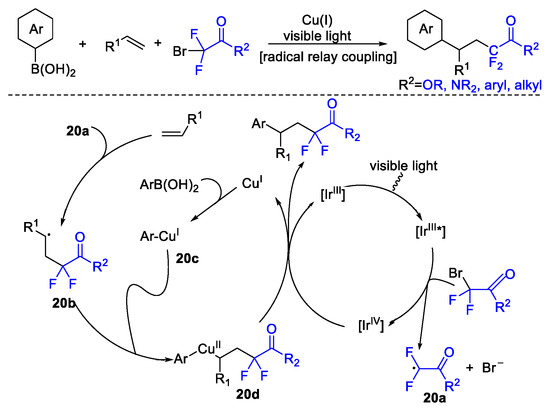
Scheme 20.
The synthesis of γ-arylation of carbonyl compounds.
Song’s group found that the difluoroalkylation–thiolation of aryl alkenes could efficiently proceed in the presence of copper/B2pin2 (Scheme 21) [56]. As an organic reducing reagent, B2pin2 plays an important role in this reaction process, enabling the simultaneous formation of C (sp3)-C (F2R) and C (sp3)-S (R) bonds by using two electrophilic substrates. Radical trapping experiments were conducted, and the results implied that the CF2CO2Et radical was involved in the catalytic cycle.
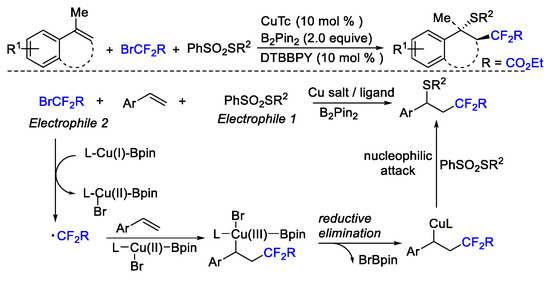
Scheme 21.
The Truce–Smiles rearrangement.
In 2019, the iron-mediated difluoroalkylation–thiolation of alkenes with BrCF2CO2Et and RSH was realized by Cai and coworkers [57]. This reaction enabled the simultaneous formation of Csp3–Csp3 and Csp3–S bonds. Thiols can be activated by FeCl2 via the Fe/S complex [58]. In the same year, the same group [59] described the photocatalyzed three-component difluoroalkylamination of alkenes using BrCF2CO2Et and amines. Besides amines and thiols, the Nishikata group found that alcohol was also a good substrate for this type of reaction (Scheme 22a) [60]. A radical and cation crossover mechanism mediated by copper was proposed as the reaction mechanism. Chen and coworkers achieved the selective three-component 1,4-difluoroalkylesterification of 1-aryl-1,3-dienes mediated by a dual copper and photoredox catalysis (Scheme 22b) [61]. This reaction provided a new method for the synthesis of difluoroalkylated allylic esters. The intramolecular two-component 1,4-difluoroalkylesterification of 1-(1,3-butadienyl) benzoic acids for the synthesis of 3-substituted benzobutyrolactones was also smoothly realized. A radical mechanism was possible for this transformation based on the results of mechanistic studies.

Scheme 22.
(a)The three-component difluoroalkylation of alkenes with BrCF2CO2Et and alcohol. (b) The three-component 1,4-difluoroalkylesterification of 1-aryl-1,3-dienes with BrCF2CO2Et and acids.
In the past few years, great progress on photocatalysis has been made in the field of organic chemistry [62,63,64,65,66,67,68,69,70,71,72,73] since the pioneer works carried out by MacMillan et al. [74] and Yoon et al. [75] in 2008. In the presence of visible light, a difluoroalkylation reaction could proceed smoothly using RCF2X as an important synthon. The reduction of RCF2X by the photocatalyst via oxidative quenching was one of the most common methods to form the RCF2 radical. A photooxidation and copper-catalyzed fluoroalkyl thionation reaction of activated and unactivated olefins with a free-radical relay mechanism was reported by Cao and coworkers (Scheme 23) [76]. By using fluorohaloalkanes as free-radical precursors, and P(O)SH or P(S)SH compounds as coupling agents, various fluorine-substituted S-alkyl thiophosphate and dithiophosphorus esters can be obtained easily under mild conditions. In addition, this reaction strategy can be successfully used for the later functionalization of bioactive molecules.
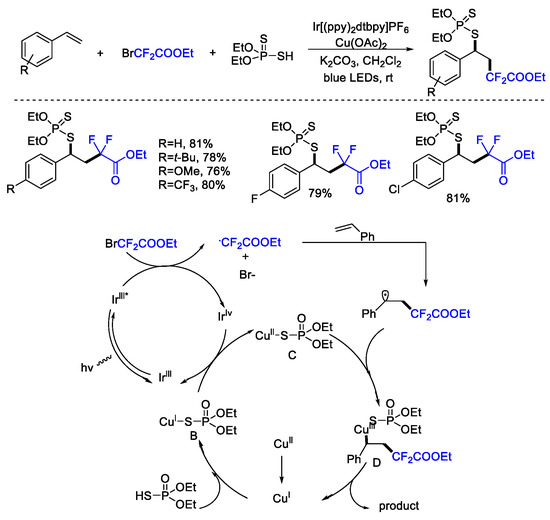
Scheme 23.
Photooxidation and copper-catalyzed fluoroalkyl thionation reaction.
Cu(I) catalyzed the three component reaction of 2-iodo-2,2-difluoroacetophenone, acetynes and TMSCN, which was presented by Wu’s group (Scheme 24) [77]. This reaction provides a simple strategy for the synthesis of difluoroacyl-substituted nitriles, which may be a potentially useful fluoro-organic intermediate for further conversion in drug discovery. The method displayed a wide substrate range and good stereoselectivity. The preliminary mechanism studies showed that a Cu(II)/Cu(I)-mediated free-radical process might be possible for this cyanodifluoroalkylation reaction.
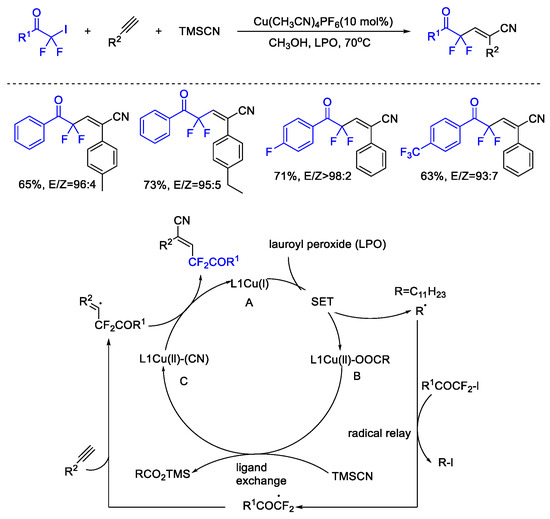
Scheme 24.
Synthesis of difluoroacyl-substituted nitriles catalyzed by copper.
A new and simple method for the difluoroalkylation of olefins mediated by the Cu/Na2S2O5 system was reported by Zhang’s group (Scheme 25) [78]. The reaction was carried out under mild conditions using readily available ingredients, where C-C and C-S bonds were successfully constructed simultaneously. The reaction shows the characteristics of a wide substrate range of olefins and disulfides, good functional group tolerance, and high selectivity. A Cu(II)/Cu(I)-mediated radical mechanism was possible for this reaction. In this catalytic cycle, the Cu(I) species is obtained via the reduction in the Cu(II) species by a solvent (CH3CN) or Na2S2O5.
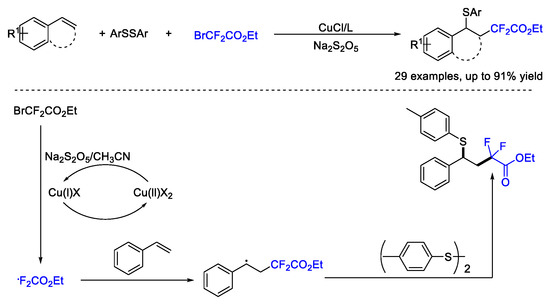
Scheme 25.
The difluoroalkylation of olefins catalyzed by Cu/Na2S2O5 system.
In 2018, Liang and coworkers showed that air-stable SCF3 and SeCF3 reagents could serve as free-radical initiators of ethyl iododifluoroacetate via a reductive reaction (Scheme 26) [79]. With the assistance of air-stable SCF3 and SeCF3 reagents, the difluoroalkylation reaction between alkynes and the ethyl iododifluoroacetate proceeded efficiently. Successful avoidance of β-proton elimination was achieved. Besides alkynes, alkenes could also react smoothly in this reaction. The Cu(I)-Cu(II)-Cu(III) mechanism was proposed for this transformation.
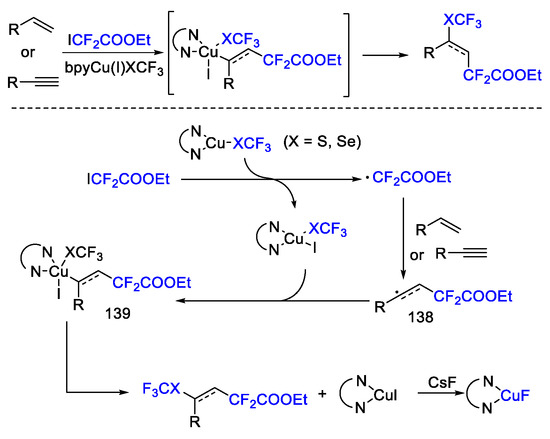
Scheme 26.
The copper-mediated difluoroalkylation reaction of alkynes with ethyl iododifluoroacetate.
4. Difluoroalkylation–Coupling Reactions
In 2018, the Cu-catalyzed oxidation of alcohols with BrCF2CO2Et was realized by Cheng and coworkers, and various difluoroalkylated aldehydes or ketones were synthesized (Scheme 27) [80]. The reaction realized the catalytic oxidation of alcohol and the difluoroalkylation of olefins at the same time, which is an efficient and attractive organic synthesis method. Similarly, the radical difluoroalkylation of alkenes, intramolecular 1, 5- or 1, 6-HAT, SET oxidation and deprotonation reactions occurred in sequence to give the desired product. Xiong’s group also carried out the Cu2O-catalyzed phosphonyldifluoromethylation and ethoxycarbonyldifluoromethylation of allylic alcohols (Scheme 28) [81]. A radical 1,2-aryl migration was possible for the reaction mechanism.
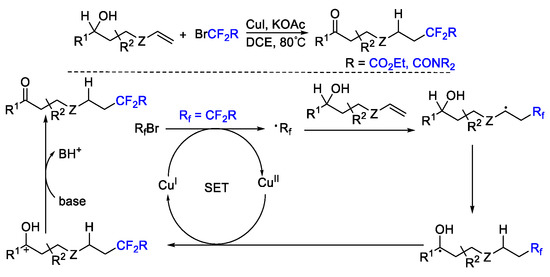
Scheme 27.
The Cu-catalyzed oxidation of alcohols with BrCF2CO2Et.

Scheme 28.
The Cu2O-catalyzed difluoromethylation of allylic alcohols.
In 2018, the copper-catalyzed difluoroacetylation of alkenes with ethyl bromodifluoroacetate (BrCF2CO2Et) was presented by Zhu’s group (Scheme 29) [82]. With the help of a base, the reduction reaction between BrCF2CO2Et and the complex of Cu(I)/B2Pin2 occurred to provide CF2COOEt radical 29c and Cu(II) 29d. Then, carbon radical intermediate 29e was formed via the addition reaction between radical 29c and alkenes, and the final product was obtained via Cu(II)-mediated oxidation and bromide capture. Alternatively, reductive elimination of Cu(III) complex 29g, which was formed from the reaction of intermediate 29e with 29d, was also reasonable.
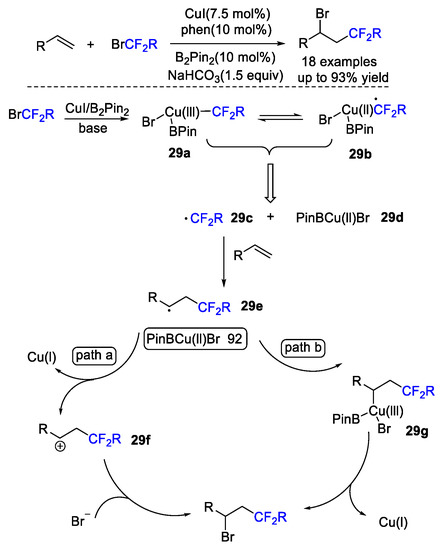
Scheme 29.
The copper-mediated difluoroacetylation of alkenes.
Wang and coworkers found that the hydrodifluoroalkylation reaction between alkynes and ethyl bromodifluoroacetate could be efficiently catalyzed by Cu (Scheme 30) [83]. Pyrosulfite should be used in this reaction as a reducing agent to inhibit the self-coupling of terminal alkynes. The SET reaction of BrCF2COOEt and Cu(I) could produce a CF2COOEt radical, which would be followed by an addition reaction with (phenylethynyl)copper 30b to form 30c. The final product was formed via hydrogen abstraction with solvents and protonation by moisture.
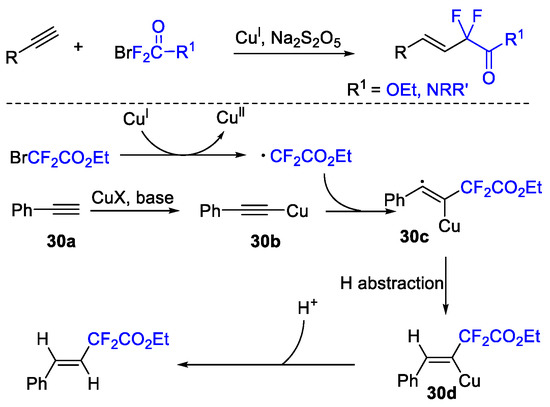
Scheme 30.
The copper-catalyzed hydrodifluoroalkylation of alkynes.
The difluoroalkylation of heteroarenes, including indoles with BrCF2CO2R catalyzed by Cu (Scheme 31a) [84] and Ru (Scheme 31b) [85], was also realized by several groups. However, a mixture of C-2 and C-3 difluoroalkylation was obtained using these strategies. Therefore, C-3-substituted indoles are usually used in this reaction to obtain the product of selective C (2)-H difluoroalkylation. The C-2 difluoromethylation of indoles and pyrroles catalyzed by copper using BrCF2CO2Et was realized by Shi’s group. However, the pyrimidyl group, which acted as a direct group, should be present (Scheme 31c) [86].
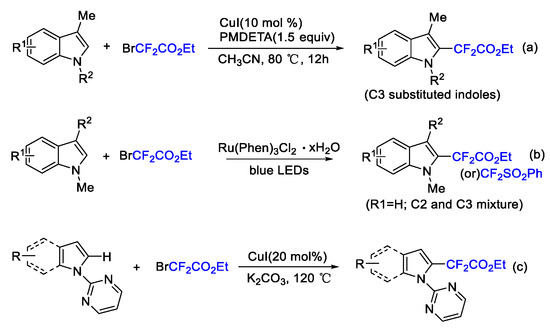
Scheme 31.
(a) Copper-catalyzed difluoroalkylation of indoles. (b) Ru-catalyzed difluoroalkylation of indoles. (c) Copper-catalyzed difluoroalkylation of indoles directed by pyrimidyl group.
As a core structure, imidazole pyridine is widely present in many bioactive molecules and drugs [87,88]. Hajra and coworkers reported the copper-catalyzed difluoroalkylation of imidazopyridines with BrCF2CO2Et (Scheme 32a) [89]. Additionally, imidazo[2,1-b]thiazole and benzo[d]imidazo[2,1-b]thiazole can also react well in this reaction system. In 2017, Fu’s group demonstrated that the photocatalyst Ir could also promote this reaction (Scheme 32b) [90]. The first organophotoredox-catalyzed difluoromethylenephosphonation of imidazoheterocycles was realized by Hajra and coworkers (Scheme 32c) [91].
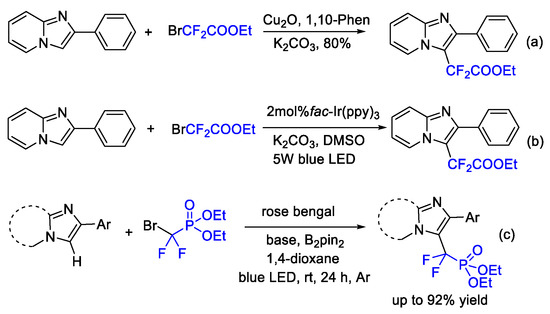
Scheme 32.
(a) Copper-catalyzed difluoroalkylation of imidazopyridines. (b) Ir-catalyzed difluoroalkylation of imidazopyridines. (c) Organophotoredox-catalyzed difluoromethylenephosphonation of imidazoheterocycles.
It was also proven that 8-aminoquinoline is capable of successfully performing difluoroalkylation with a difluoromethyl bromide reagent. The copper/B2pin2-mediated C-H ethoxycarbonyldifluoromethylation of 8-aminoquinoline scaffolds at the C5 position with functionalized difluoromethyl bromides and iodines was presented by Wu and coworkers (Scheme 33a) [92]. Ethoxycarbonyldifluoromethylation of naphthalenes at the C4 position was also realized in this system. Additionally, Ni- (Scheme 33b) [93] and Ru-mediated (Scheme 33c) [94] difluoromethylation of 8-aminoquinoline was reported separately by Wu, Wang and Zhao’s groups.

Scheme 33.
(a)The Cu-catalyzed difluoroalkylation of 8-aminoquinoline. (b) The Ni-catalyzed difluoroalkylation of 8-aminoquinoline. (c) The Ru-catalyzed difluoroalkylation of 8-aminoquinoline.
Quinoxaline-2-ketone derivatives are widely found in bioactive molecules [71,95]. In 2019, the direct C-3 difluoroacetylation of quinoxalinones using ethyl bromodifluoroacetate catalyzed by copper was reported by Zhang’s group (Scheme 34) [96]. Control experiments were performed, implying that the CF2COOEt radical was involved in the catalytic cycle. Various difluoroacetylated quinoxalin-2(1H)-ones, which contained a wide range of functional groups, were isolated smoothly with moderate to excellent yields.
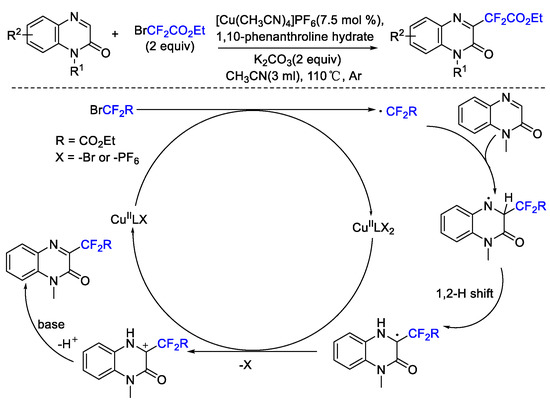
Scheme 34.
The copper-catalyzed direct C-3 difluoroacetylation of quinoxalinones.
In 2019, the copper-catalyzed difluoroalkylation of arenes with difluoroalkylation reagents (BrCF2CO2Et or BrCF2CONR1R2) in the presence of visible light was realized by Liu and coworkers (Scheme 35) [97]. The in situ reaction of cuprous iodide, a triaryl phosphine ligand and an imine ligand formed a cuprous photocatalyst, playing a key role in this reaction. Difluoromethyl radicals that were changed via single-electron transfer from the excited photocatalyst into difluoroalkylation reagents were suggested in the difluoroalkylation reaction.
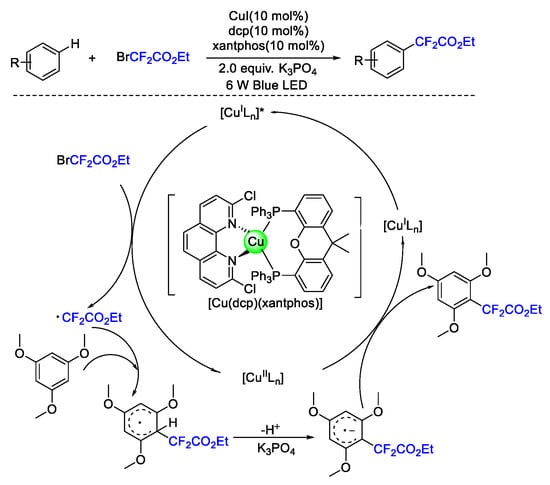
Scheme 35.
Visible-light-induced difluoroalkylation of arenes.
In 2016, the Cu(I)-catalyzed difluoroalkylation of hydrazones was realized by Monteiro’s group (Scheme 36a) [98]. Besides a copper catalyst, Pd2(dba)3 (Scheme 36b) [99], Ir (Scheme 36c) [100] and Au (Scheme 36d) [101] were also found to be effective in this reaction. The difluoroalkylation reaction between hydrazones and difluoroalkyl bromides catalyzed by Cu(II)/B2pin2 using diboron as a reductant was presented by Song and coworkers (Scheme 37) [102]. Both aliphatic and aromatic hydrazones can react smoothly in this reaction system. The SET reaction, which could provide a difluoroalkyl radical, was suggested in the catalytic cycle. Additionally, the diboron reagent played a key role in this reaction.
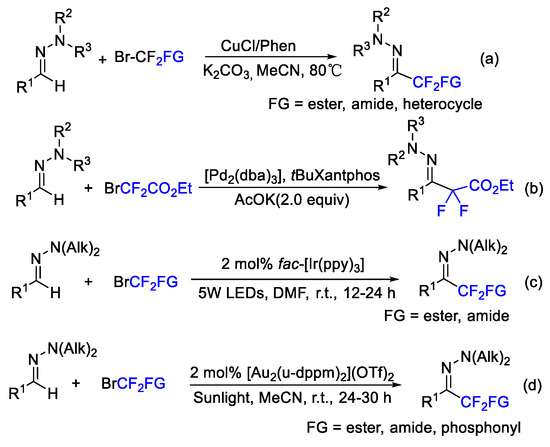
Scheme 36.
(a) Copper-catalyzed difluoroalkylation of hydrazones. (b) Pd-catalyzed difluoroalkylation of hydrazones. (c) Ir-catalyzed difluoroalkylation of hydrazones. (d) Au-catalyzed difluoroalkylation of hydrazones.
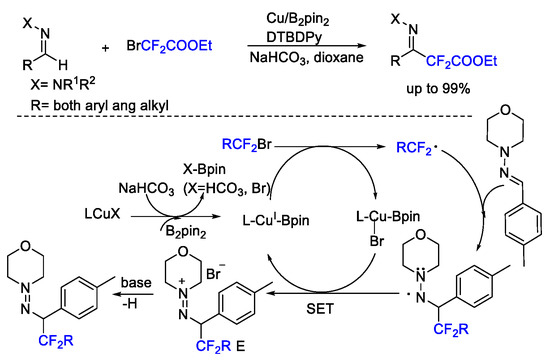
Scheme 37.
The Cu/B2pin2-catalyzed difluoroalkylation of hydrazones.
Molander and colleagues described a metal photoredox method for the preparation of fluoroalkyl aromatic hydrocarbons based on a bicatalytic Ir/Cu synergistic combination with boric acid (Scheme 38) [103]. Mild reaction conditions could tolerate a wide range of functional groups, such as aldehydes, free phenols, and N-BOC-protective amines. Mechanism studies support the process of photooxidation/copper dual catalysis. Reductive quenching of the excited photocatalyst Ir(III)* by Cu(I) was described in the catalytic cycle.
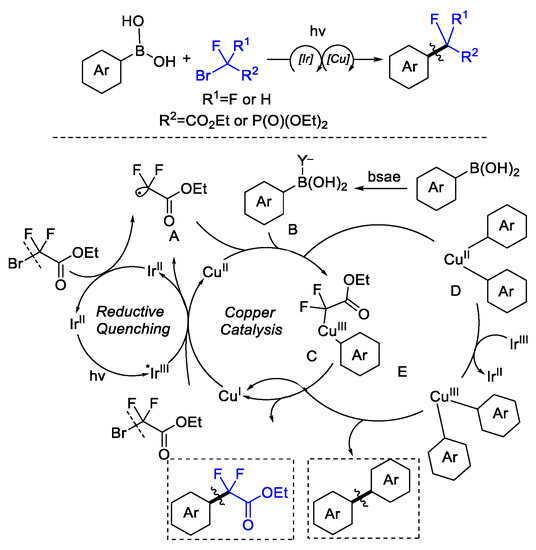
Scheme 38.
The Cu/B2pin2-catalyzed difluoroalkylation of hydrazones.
The free-radical alkylation of copper-catalyzed aryl acetylene with bromodifluoroamide was studied by Zhao’s group (Scheme 39) [104]. This reaction shows good functional group tolerance, and provides various substituted α-alkynyl-α, α-difluoroacetamides with medium to good yields. The potential for amplifying reactions and the derivatization of products also makes this method a great choice for practical applications. Preliminary mechanistic studies implied that catalytic systems may involve free-radical reaction pathways.

Scheme 39.
The Cu/B2pin2-catalyzed difluoroalkylation of hydrazones.
An effective method for the selective C-H difluoroalkylation of coumarins catalyzed by copper is reported in [105] (Scheme 40). It is easy to obtain ethyl bromodifluoroacetate and N-phenylbromodifluoroacetamide. The reaction showed good functional group tolerance to coumarins and difluoroalkylation reagents, and several redox-sensitive substrates have been successfully applied to this difluoroalkylation reaction. This system can be further extended to other heterocyclic aromatic hydrocarbons, including furan, benzofuran, pyrrole, pyridone, chromone, indole and quinolinone. The in situ formation of fluoroalkyl radicals was proposed in this copper-catalyzed reaction.

Scheme 40.
The selective C-H difluoroalkylation of coumarins catalyzed by copper.
Under microwave irradiation, the catalytic amount of oxidant Cu(OAc)2 was successfully applied to form transient difluoroalkyl radicals in situ for the first time (Scheme 41) [106]. The synthetic utility of this new method is also used to synthesize difluoroalkylated spirohexadienone, which is an important core structure in various natural products and pharmaceuticals. The Cu(II)/Cu(I)-mediated single-electron oxidation was described in the reaction mechanism.
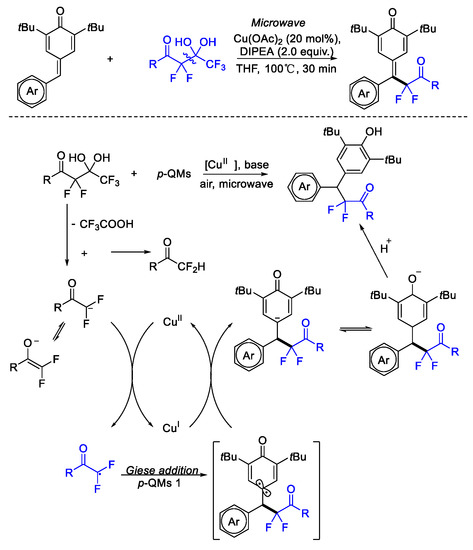
Scheme 41.
The microwave-assisted copper catalysis of α-difluorinated gem-diol.
5. Conclusions
Much progress has been made in the reaction of copper-catalyzed difluoroalkylation. In this review, the progress made with regard to copper-catalyzed difluoroalkylation reactions was summarized. At present, both visible-light-induced and metal-catalyzed difluoroalkylation were successfully realized. When alkenes or alkynes were subjected to these reactions, a radical addition to the carbon–carbon unsaturated bonds was usually proposed in the reaction mechanism; then, the corresponding products can be generated in different ways. RCF2X is the most commonly used difluoroalkylation reagent. In most cases, the reduction of RCF2X by copper to form the RCF2 radical was possible.
The C (sp3)-H bond has a high bond-dissociation energy, and lacks the “active” HOMO or LUMO orbital that interacts with the transition metal’s catalytic center, making it more difficult to functionalize the C (sp3)-H bond. The copper-catalyzed difluoroalkylation of the C(sp3)-H bond needs to be further researched. Considering green chemistry and cost-effectiveness, cheaper photocatalysts or even catalyst-free difluoroalkylation reactions are more desirable. There were only a few cases of visible-light-induced difluoroalkylation reactions catalyzed by copper reported in the literature. This issue is also worthy of further study. Asymmetric difluoroalkylation has not been reported yet. In addition, the multicomponent reaction when introducing the RCF2 group also needs further exploration. We expect that this review will highlight new ways for the development of difluoroalkylation reaction.
Author Contributions
The manuscript was written through the contributions of all authors. All authors have read and agreed to the published version of the manuscript.
Funding
This work was supported by the National Natural Science Foundation of China (Nos. 21772107), Shandong Province Key Research and Development Plan (No. 2019GSF108017), and Youth Innovation Team Project for Talent Introduction and Cultivation in Universities of Shandong Province (2021).
Institutional Review Board Statement
Not applicable.
Informed Consent Statement
Not applicable.
Conflicts of Interest
The authors declare no conflict of interest.
References
- Vulpetti, A.; Dalvit, C. Fluorine local environment: From screening to drug design. Drug Discov. Today 2012, 17, 890–897. [Google Scholar] [CrossRef] [PubMed]
- Dilman, A.D.; Levin, V.V. Difluorocarbene as a Building Block for Consecutive Bond-Forming Reactions. Acc. Chem. Res. 2018, 51, 1272–1280. [Google Scholar] [CrossRef] [PubMed]
- Lasing, T.; Phumee, A.; Siriyasatien, P.; Chitchak, K.; Vanalabhpatana, P.; Mak, K.K.; Hee Ng, C.; Vilaivan, T.; Khotavivattana, T. Synthesis and antileishmanial activity of fluorinated rhodacyanine analogues: The ‘fluorine-walk’ analysis. Bioorg. Med. Chem. 2020, 28, 115187. [Google Scholar] [CrossRef]
- Cech, R.; Zaller, J.G.; Lyssimachou, A.; Clausing, P.; Hertoge, K.; Linhart, C. Pesticide drift mitigation measures appear to reduce contamination of non-agricultural areas, but hazards to humans and the environment remain. Sci. Total Environ. 2023, 854, 158814. [Google Scholar] [CrossRef] [PubMed]
- Xiao, X.; Cai, H.; Huang, Q.; Wang, B.; Wang, X.; Luo, Q.; Li, Y.; Zhang, H.; Gong, Q.; Ma, X.; et al. Polymeric dual-modal imaging nanoprobe with two-photon aggregation-induced emission for fluorescence imaging and gadolinium-chelation for magnetic resonance imaging. Bioact. Mater. 2023, 19, 538–549. [Google Scholar] [CrossRef] [PubMed]
- Naz, F.; Arish, M. GPCRs as an emerging host-directed therapeutic target against mycobacterial infection: From notion to reality. Br. J. Pharmacol. 2022, 179, 4899–4909. [Google Scholar] [CrossRef] [PubMed]
- Zhang, P.B.; Wang, C.; Cui, M.C.; Du, M.S.; Li, W.W.; Jia, Z.X.; Zhao, Q. Synthesis of Difluoroalkylated Benzofuran, Benzothiophene, and Indole Derivatives via Palladium-Catalyzed Cascade Difluoroalkylation and Arylation of 1,6-Enynes. Org. Lett. 2020, 22, 1149–1154. [Google Scholar] [CrossRef]
- Sun, H.; Jiang, Y.; Yang, Y.-S.; Li, Y.-Y.; Li, L.; Wang, W.-X.; Feng, T.; Li, Z.-H.; Liu, J.-K. Synthesis of difluoromethylated 2-oxindoles and quinoline-2,4-diones via visible light-induced tandem radical cyclization of N-arylacrylamides. Org. Biomol. Chem. 2019, 17, 6629–6638. [Google Scholar] [CrossRef]
- Zhou, J.; Wang, F.; Lin, Z.; Cheng, C.; Zhang, Q.; Li, J. Visible-Light-Induced para-Selective C(sp(2))-H Difluoroalkylation of Diverse (Hetero)aromatic Carbonyls. Org. Lett. 2020, 22, 68–72. [Google Scholar] [CrossRef]
- Taguchi, T.; Kitagawa, O.; Morikawa, T.; Nishiwaki, T.; Uehara, H.; Endo, H.; Kobayashi, Y. Synthesis of 2,2-difluoroesters by iododifluoroacetate-copper with organic halides. Tetrahedron Lett. 1986, 27, 6103–6106. [Google Scholar] [CrossRef]
- Soni, V.; Sharma, D.M.; Punji, B. Nickel-Catalyzed Regioselective C(2)-H Difluoroalkylation of Indoles with Difluoroalkyl Bromides. Chem. Asian J. 2018, 13, 2516–2521. [Google Scholar] [CrossRef] [PubMed]
- Xie, X.J.; Zhang, Y.F.; Hao, J.; Wan, W. Ag-Catalyzed minisci C-H difluoromethylarylation of N-heteroarenes. Org. Biomol. Chem. 2020, 18, 400–404. [Google Scholar] [CrossRef] [PubMed]
- Ouyang, Y.; Qing, F.L. New Strategy for the Construction of Chiral Cyclopropenes: Enantioselective Synthesis of Gem-difluoromethylenated Three-Membered Carbocycles. Chin. J. Org. Chem. 2020, 40, 806–807. [Google Scholar] [CrossRef]
- Feng, Z.; Xiao, Y.L.; Zhang, X.G. Transition-Metal (Cu, Pd, Ni)-Catalyzed Difluoroalkylation via Cross-Coupling with Difluoroalkyl Halides. Acc. Chem. Res. 2018, 51, 2264–2278. [Google Scholar] [CrossRef] [PubMed]
- Liu, W.; Yan, W.; Paeth, M.; Zacate, S.; Zeng, X. Late-Stage Difluoromethylation of Aliphatic Carboxylic Acids with Copper Catalysis. Synlett 2020, 31, 745–749. [Google Scholar] [CrossRef]
- Tao, X.F.; Sheng, R.; Bao, K.; Wang, Y.X.; Jin, Y.X. Progress of Difluoromethyl Heteroaryl Sulfones as Difluoroalkylation Reagents. Chin. J. Org. Chem. 2019, 39, 2726–2734. [Google Scholar] [CrossRef]
- Wang, W.; Yu, Q.; Zhang, Q.; Li, J.; Hui, F.; Yang, J.; Lü, J. Recent Progress on Difluoromethylation Methods. Chin. J. Org. Chem. 2018, 38, 1569–1585. [Google Scholar] [CrossRef]
- Dong, D.-Q.; Yang, H.; Shi, J.-L.; Si, W.-J.; Wang, Z.-L.; Xu, X.-M. Promising reagents for difluoroalkylation. Org. Chem. Front. 2020, 7, 2538–2575. [Google Scholar] [CrossRef]
- Gui, Q.W.; Teng, F.; Yang, H.; Xun, C.; Huang, W.J.; Lu, Z.Q.; Zhu, M.X.; Ouyang, W.T.; He, W.M. Visible-Light Photosynthesis of CHF2 /CClF2 /CBrF2 -Substituted Ring-fused Quinazolinones in Dimethyl Carbonate. Chem. Asian J. 2022, 17, e202101139. [Google Scholar] [CrossRef]
- Li, X.; Jiang, M.; Zhu, X.; Song, X.; Deng, Q.; Lv, J.; Yang, D. A desulphurization strategy for Sonogashira couplings by visible light/copper catalysis. Org. Chem. Front. 2022, 9, 386–393. [Google Scholar] [CrossRef]
- Cui, W.; Li, Y.; Li, X.; Li, J.; Song, X.; Lv, J.; Jiang, Y.-Y.; Yang, D. Rapid formation of Csp3–Csp3 bonds through copper-catalyzed decarboxylative Csp3–H functionalization. Chin. Chem. Lett. 2023, 34, 107477. [Google Scholar] [CrossRef]
- Chen, X.-J.; Gui, Q.-W.; Yi, R.; Yu, X.; Wu, Z.-L.; Huang, Y.; Cao, Z.; He, W.-M. Copper(i)-catalyzed intermolecular cyanoarylation of alkenes: Convenient access to α-alkylated arylacetonitriles. Org. Biomol. Chem. 2020, 18, 5234–5237. [Google Scholar] [CrossRef] [PubMed]
- Li, G.H.; Dong, D.Q.; Yang, Y.; Yu, X.Y.; Wang, Z.L. Direct Carbamoylation of Quinoline N-oxides with Hydrazinecarboxamides via C-H Bond Activation Catalyzed by Copper Catalyst. Adv. Synth. Catal. 2019, 361, 832–835. [Google Scholar]
- Bhunia, S.; Pawar, G.G.; Kumar, S.V.; Jiang, Y.W.; Ma, D.W. Selected Copper-Based Reactions for C-N, C-O, C-S, and C-C Bond Formation. Angew. Chem. Int. Ed. 2017, 56, 16136–16179. [Google Scholar] [CrossRef] [PubMed]
- Worrell, B.T.; Malik, J.A.; Fokin, V.V. Direct Evidence of a Dinuclear Copper Intermediate in Cu(I)-Catalyzed Azide-Alkyne Cycloadditions. Science 2013, 340, 457–460. [Google Scholar] [CrossRef]
- Gephart, R.T.; Warren, T.H. Copper-Catalyzed sp(3) C-H Amination. Organometallics 2012, 31, 7728–7752. [Google Scholar] [CrossRef]
- Cui, W.; Li, X.; Guo, G.; Song, X.; Lv, J.; Yang, D. Radial Type Ring Opening of Sulfonium Salts with Dichalcogenides by Visible Light and Copper Catalysis. Org. Lett. 2022, 24, 5391–5396. [Google Scholar] [CrossRef] [PubMed]
- Yan, Q.; Cui, W.; Song, X.; Xu, G.; Jiang, M.; Sun, K.; Lv, J.; Yang, D. Sulfonylation of Aryl Halides by Visible Light/Copper Catalysis. Org. Lett. 2021, 23, 3663–3668. [Google Scholar] [CrossRef]
- Zhu, X.; Li, X.; Li, X.; Lv, J.; Sun, K.; Song, X.; Yang, D. Decarboxylative C–H alkylation of heteroarenes by copper catalysis. Org. Chem. Front. 2021, 8, 3128–3136. [Google Scholar] [CrossRef]
- Gan, Z.; Yan, Q.; Li, G.; Li, Q.; Dou, X.; Li, G.-Y.; Yang, D. Copper-Catalyzed Domino Synthesis of Sulfur-Containing Heterocycles Using Carbon Disulfide as a Building Block. Adv. Synth. Catal. 2019, 361, 4558–4567. [Google Scholar] [CrossRef]
- Zhang, T.T.; Chen, B.; Wang, W.; Zhang, Q.; Wang, P.Y.; Wan, W.; Deng, H.M.; Hao, J.; Jiang, H.Z. Copper-Promoted Aryldifluoromethylenation of N-Arylacrylamides to 3-Benzo-diazolyldifluoromethylene-Substituted 2-Oxindoles. Asian J. Org. Chem. 2019, 8, 671–674. [Google Scholar] [CrossRef]
- Ding, F.; Fang, Y.; Jiang, Y.; Lin, K.; Shi, L. Tandem Radical Cyclization for the Construction of Difluoro-Containing Oxindoles and Quinoline-2,4-diones. Chem. Asian J. 2018, 13, 636–640. [Google Scholar] [CrossRef] [PubMed]
- Liu, C.; Yang, Y.J.; Dong, J.Y.; Zhou, M.D.; Li, L.; Wang, H. Copper/B(2)pin(2)-Catalyzed Difluoroalkylation of Methylenecyclopropanes with Bromodifluorinated Acetates and Acetamides: One-Pot Synthesis of CF2-Containing Dihydronaphthalene Derivatives. J. Org. Chem. 2019, 84, 9937–9945. [Google Scholar] [CrossRef] [PubMed]
- Wang, J.; Sánchez-Roselló, M.; Aceña, J.L.; del Pozo, C.; Sorochinsky, A.E.; Fustero, S.; Soloshonok, V.A.; Liu, H. Fluorine in Pharmaceutical Industry: Fluorine-Containing Drugs Introduced to the Market in the Last Decade (2001–2011). Chem. Rev. 2014, 114, 2432–2506. [Google Scholar] [CrossRef] [PubMed]
- Anderson, M.O.; Zhang, J.; Liu, Y.; Yao, C.; Phuan, P.-W.; Verkman, A.S. Nanomolar Potency and Metabolically Stable Inhibitors of Kidney Urea Transporter UT-B. J. Med. Chem. 2012, 55, 5942–5950. [Google Scholar] [CrossRef]
- Médebielle, M. Electrochemical addition of chlorodifluoroacetyl aromatic compounds to electron-rich olefinic substrates—A convenient synthesis of gem-difluoro heterocyclic compounds. Tetrahedron Lett. 1995, 36, 2071–2074. [Google Scholar] [CrossRef]
- Qu, C.; Xu, P.; Ma, W.; Cheng, Y.; Zhu, C. A novel visible light mediated radical cyclization of enol lactones: A concise method for fluorinated polycyclic lactone scaffolds. Chem. Commun. 2015, 51, 13508–13510. [Google Scholar] [CrossRef]
- Peng, P.; Huang, G.Z.; Sun, Y.X.; Wang, X.; Wu, J.J.; Wu, F.H. Copper-mediated cascade radical cyclization of olefins with naphthalenyl iododifluoromethyl ketones. Org. Biomol. Chem. 2019, 17, 6426–6431. [Google Scholar] [CrossRef]
- Wang, X.; Liu, J.; Yu, Z.; Guo, M.; Tang, X.; Wang, G. Desulfonylation-Initiated Distal Alkenyl Migration in Copper-Catalyzed Alkenylation of Unactivated Alkenes. Org. Lett. 2018, 20, 6516–6519. [Google Scholar] [CrossRef]
- Ke, M.; Song, Q. Copper/B2pin2-catalyzed C-H difluoroacetylation-cycloamidation of anilines leading to the formation of 3,3-difluoro-2-oxindoles. Chem. Commun. 2017, 53, 2222–2225. [Google Scholar] [CrossRef]
- Cao, A.Z.; Xiao, Y.T.; Wu, Y.C.; Song, R.J.; Xie, Y.X.; Li, J.H. Copper-catalyzed C-H [3 + 2] annulation of N-substituted anilines with alpha-carbonyl alkyl bromides via C(sp(3))-Br/C(sp(2))-H functionalization. Org. Biomol. Chem. 2020, 18, 2170–2174. [Google Scholar] [CrossRef] [PubMed]
- Li, Z.; Wu, Y.H.; Xi, J.M.; Wei, Z.L.; Liao, W.W. Copper-Catalyzed Difluoroalkylation of Alkene/Nitrile Insertion/Cyclization Tandem Sequences: Construction of Difluorinated Bicyclic Amidines. Org. Lett. 2021, 23, 9591–9596. [Google Scholar] [CrossRef] [PubMed]
- Da, Y.; Han, S.; Du, X.; Liu, S.; Liu, L.; Li, J. Copper(I)-Catalyzed Oxydifluoroalkylation of Alkenes: A Route to Functionalization of Lactones. Org. Lett. 2018, 20, 5149–5152. [Google Scholar] [CrossRef]
- Yuan, F.Y.; Zhou, S.; Yang, Y.Y.; Guo, M.J.; Tang, X.Y.; Wang, G.W. Copper catalyzed one-pot difluoroalkylation and lactonization of unsaturated carboxylic acids. Org. Chem. Front. 2018, 5, 3306–3309. [Google Scholar] [CrossRef]
- Yang, Y.; Yuan, F.; Ren, X.; Wang, G.; Zhao, W.; Tang, X.; Guo, M. Copper-Catalyzed Oxydifluoroalkylation of Hydroxyl-Containing Alkenes. J. Org. Chem. 2019, 84, 4507–4516. [Google Scholar] [CrossRef] [PubMed]
- Wang, X.Y.; Li, M.; Yang, Y.Y.; Guo, M.J.; Tang, X.Y.; Wang, G.W. One-pot Construction of Difluorinated Pyrrolizidine and Indolizidine Scaffolds via Copper-Catalyzed Radical Cascade Annulation. Adv. Synth. Catal. 2018, 360, 2151–2156. [Google Scholar] [CrossRef]
- Liao, J.; Ouyang, L.; Lai, Y.; Luo, R. Photoredox-Catalyzed Oxy-/Aminofluoroalkylative Cyclization of Alkenes. J. Org. Chem. 2020, 85, 5590–5597. [Google Scholar] [CrossRef] [PubMed]
- Fu, W.Q.; Song, Q. Copper-Catalyzed Radical Difluoroalkylation and Redox Annulation of Nitroalkynes for the Construction of C2-Tetrasubstituted Indolin-3-ones. Org. Lett. 2018, 20, 393–396. [Google Scholar] [CrossRef]
- Ding, F.W.; Jiang, Y.Q.; Lin, K.F.; Shi, L. Tandem radical cyclization for the construction of 1-difluoroalkylated isoquinolines via Cu catalyzed and visible light-promoted pathways. Org. Biomol. Chem. 2018, 16, 1812–1815. [Google Scholar] [CrossRef]
- Ma, X.; Mai, S.; Zhou, Y.; Cheng, G.J.; Song, Q. Dual role of ethyl bromodifluoroacetate in the formation of fluorine-containing heteroaromatic compounds. Chem. Commun. 2018, 54, 8960–8963. [Google Scholar] [CrossRef]
- Wang, L.X.; Chen, H.T.; Zhao, W.T.; Wang, G.W. Copper-Catalyzed Oxydifluoroalkylation of beta, gamma-Unsaturated Oximes for the Construction of Isoxazolines with a Difluoroalkyl Side Chain. Synlett 2021, 32, 1029–1033. [Google Scholar] [CrossRef]
- Zhu, S.Q.; Yang, H.B.; Jiang, A.; Zhou, B.; Han, Y.; Yan, C.G.; Shi, Y.C.; Hou, H. Copper-Catalyzed Bromodifluoroacetylative Cyclization of Enynes. J. Org. Chem. 2020, 85, 15667–15675. [Google Scholar] [CrossRef] [PubMed]
- Zhang, Y.; Zhang, J.; Hu, B.; Ji, M.; Ye, S.; Zhu, G. Synthesis of Difluoromethylated and Phosphorated Spiro[5.5]trienones via Dearomative Spirocyclization of Biaryl Ynones. Org. Lett. 2018, 20, 2988–2992. [Google Scholar] [CrossRef] [PubMed]
- Li, C.W.; Zhao, Y.L.; Zhou, J.X.; Wang, X.; Hou, J.L.; Song, Y.G.; Liu, W.J.; Han, G.F. Synthesis of difluoroalkylated 2-azaspiro 4.5 decane derivatives via copper-catalyzed difluoroalkylation/dearomatization of N-benzylacrylamides. Org. Biomol. Chem. 2020, 18, 8376–8380. [Google Scholar] [CrossRef]
- Lv, X.L.; Wang, C.; Wang, Q.L.; Shu, W. Rapid Synthesis of gamma-Arylated Carbonyls Enabled by the Merge of Copper- and Photocatalytic Radical Relay Alkylarylation of Alkenes. Org. Lett. 2019, 21, 56–59. [Google Scholar] [CrossRef]
- Kong, W.; Yu, C.; An, H.; Song, Q. Copper-Catalyzed Intermolecular Reductive Radical Difluoroalkylation-Thiolation of Aryl Alkenes. Org. Lett. 2018, 20, 4975–4978. [Google Scholar] [CrossRef]
- Xu, R.; Cai, C. Three-component difluoroalkylation-thiolation of alkenes by iron-facilitated visible-light photoredox catalysis. Chem. Commun. 2019, 55, 4383–4386. [Google Scholar] [CrossRef]
- Hagen, K.S.; Reynolds, J.G.; Holm, R.H. Definition of reaction sequences resulting in self-assembly of [Fe4S4(SR)4]2- clusters from simple reactants. J. Am. Chem. Soc. 1981, 103, 4054–4063. [Google Scholar] [CrossRef]
- Xu, R.; Cai, C. Three-component difluoroalkylamination of alkenes mediated by photoredox and iron cooperative catalysis. Org. Biomol. Chem. 2019, 17, 8541–8545. [Google Scholar] [CrossRef]
- Murata, Y.; Shimada, T.; Nishikata, T. Radical and Cation Crossover Reaction System Enables Synthesis of Complex Aliphatic Chains Possessing Functionalized Quaternary Carbons. Bull. Chem. Soc. Jpn. 2019, 92, 1419–1429. [Google Scholar] [CrossRef]
- Bi, M.-H.; Cheng, Y.; Xiao, W.-J.; Chen, J.-R. Visible-Light-Induced Photoredox-Catalyzed Selective 1,4-Difluoroalkylesterification of 1-Aryl-1,3-dienes. Org. Lett. 2022, 24, 7589–7594. [Google Scholar] [CrossRef] [PubMed]
- Lemos, A.; Lemaire, C.; Luxen, A. Progress in Difluoroalkylation of Organic Substrates by Visible Light Photoredox Catalysis. Adv. Synth. Catal. 2019, 361, 1500–1537. [Google Scholar] [CrossRef]
- Liu, Q.; Wu, L.-Z. Recent advances in visible-light-driven organic reactions. Natl. Sci. Rev. 2017, 4, 359–380. [Google Scholar] [CrossRef]
- Chen, Y.; Lu, L.-Q.; Yu, D.-G.; Zhu, C.-J.; Xiao, W.-J. Visible light-driven organic photochemical synthesis in China. Sci. Chin. Chem. 2018, 62, 24–57. [Google Scholar] [CrossRef]
- Gui, Q.W.; Teng, F.; Li, Z.C.; Xiong, Z.Y.; Jin, X.F.; Lin, Y.W.; Cao, Z.; He, W.M. Visible-light-initiated tandem synthesis of difluoromethylated oxindoles in 2-MeTHF under additive-, metal catalyst-, external photosensitizer-free and mild conditions. Chin. Chem. Lett. 2021, 32, 1907–1910. [Google Scholar] [CrossRef]
- He, S.; Chen, X.; Zeng, F.; Lu, P.; Peng, Y.; Qu, L.; Yu, B. Visible-light-promoted oxidative decarboxylation of arylacetic acids in air: Metal-free synthesis of aldehydes and ketones at room temperature. Chin. Chem. Lett. 2020, 31, 1863–1867. [Google Scholar] [CrossRef]
- Sun, Y.Y.; Song, J.C.; Yang, S.H.; Wang, Z.L.; Zhang, E.X.; Han, Q.Q.; Yue, S. Visible light induced radical cascade cyclization of ortho-cyanoarylacrylamides with phosphine oxides for the preparation of phosphorylated quinoline-2,4(1H,3H)-dione. New J. Chem. 2021, 45, 16438–16441. [Google Scholar] [CrossRef]
- Dong, D.; Yue, S.; Wang, Z.; Yang, S.; Han, Q.; Zhang, E.; Qin, Q.; Song, J.; Sun, Y. Recent Progress in Radical Arylation Reaction with Diaryliodonium Salts under Photocatalysis. Chin. J. Org. Chem. 2021, 41, 4651–4660. [Google Scholar]
- Li, G.-H.; Han, Q.-Q.; Sun, Y.-Y.; Chen, D.-M.; Wang, Z.-L.; Xu, X.-M.; Yu, X.-Y. Visible-light induced cascade radical cyclization of sulfinic acids and o-(allyloxy)arylaldehydes towards functionalized chroman-4-ones. Chin. Chem. Lett. 2020, 31, 3255–3258. [Google Scholar] [CrossRef]
- Yang, W.-C.; Chen, C.-Y.; Li, J.-F.; Wang, Z.-L. Radical denitrogenative transformations of polynitrogen heterocycles: Building C–N bonds and beyond. Chin. J. Catal. 2021, 42, 1865–1875. [Google Scholar] [CrossRef]
- Xie, L.-Y.; Liu, Y.-S.; Ding, H.-R.; Gong, S.-F.; Tan, J.-X.; He, J.-Y.; Cao, Z.; He, W.-M. C(sp2)–H/O–H cross-dehydrogenative coupling of quinoxalin-2(1H)-ones with alcohols under visible-light photoredox catalysis. Chin. J. Catal. 2020, 41, 1168–1173. [Google Scholar] [CrossRef]
- He, W.-B.; Gao, L.-Q.; Chen, X.-J.; Wu, Z.-L.; Huang, Y.; Cao, Z.; Xu, X.-H.; He, W.-M. Visible-light-initiated malic acid-promoted cascade coupling/cyclization of aromatic amines and KSCN to 2-aminobenzothiazoles without photocatalyst. Chin. Chem. Lett. 2020, 31, 1895–1898. [Google Scholar] [CrossRef]
- Wang, P.; Zhao, Q.; Xiao, W.; Chen, J. Recent advances in visible-light photoredox-catalyzed nitrogen radical cyclization. Green Synth. Catal. 2020, 1, 42–51. [Google Scholar] [CrossRef]
- Nicewicz, D.A.; MacMillan, D.W.C. Merging photoredox catalysis with organocatalysis: The direct asymmetric alkylation of aldehydes. Science 2008, 322, 77–80. [Google Scholar] [CrossRef]
- Ischay, M.A.; Anzovino, M.E.; Du, J.; Yoon, T.P. Efficient Visible Light Photocatalysis of [2+2] Enone Cycloadditions. J. Am. Chem. Soc. 2008, 130, 12886–12887. [Google Scholar] [CrossRef] [PubMed]
- Zhang, P.B.; Li, W.W.; Qu, W.L.; Shu, Z.G.; Tao, Y.J.; Lin, J.M.; Gao, X. Copper and Photocatalytic Radical Relay Enabling Fluoroalkylphosphorothiolation of Alkenes: Modular Synthesis of Fluorine-Containing S-Alkyl Phosphorothioates and Phosphorodithioates. Org. Lett. 2021, 23, 9267–9272. [Google Scholar] [CrossRef]
- Wu, P.J.; Zheng, C.; Wang, X.; Wu, J.J.; Wu, F.H. Copper-Catalyzed Three-Component Reactions of 2-Iodo-2,2-difluoroacetophenones, Alkynes, and Trimethylsilyl Cyanide. Eur. J. Org. Chem. 2021, 2021, 1420–1423. [Google Scholar] [CrossRef]
- Gao, B.; Ni, Y.J.; Liu, X.J.; Jiang, T.; Yan, Q.; Yang, R.T.; Zhang, X.L. Copper-Catalyzed Difluoroalkylation-Thiolation of Alkenes Promoted by Na2S2O5. Eur. J. Org. Chem. 2021, 2021, 1913–1918. [Google Scholar] [CrossRef]
- Zhang, B.S.; Gao, L.Y.; Zhang, Z.; Wen, Y.H.; Liang, Y.M. Three-component difluoroalkylation and trifluoromethylthiolation/trifluoromethylselenolation of pi-bonds. Chem. Commun. 2018, 54, 1185–1188. [Google Scholar] [CrossRef]
- Zhang, J.; Jin, W.; Cheng, C.; Luo, F. Copper-catalyzed remote oxidation of alcohols initiated by radical difluoroalkylation of alkenes: Facile access to difluoroalkylated carbonyl compounds. Org. Biomol. Chem. 2018, 16, 3876–3880. [Google Scholar] [CrossRef]
- Hu, L.; Deng, Q.; Zhou, Y.; Zhang, X.; Xiong, Y. Cu2O-catalyzed phosphonyldifluoromethylation of allylic alcohols through a radical 1,2-aryl migration. Tetrahedron 2020, 76, 130949. [Google Scholar] [CrossRef]
- Li, D.; Mao, T.; Huang, J.; Zhu, Q. Copper-Catalyzed Bromodifluoroacetylation of Alkenes with Ethyl Bromodifluoroacetate. J. Org. Chem. 2018, 83, 10445–10452. [Google Scholar] [CrossRef]
- Feng, X.R.; Wang, X.Y.; Chen, H.T.; Tang, X.Y.; Guo, M.J.; Zhao, W.T.; Wang, G.W. Copper-mediated regioselective hydrodifluoroalkylation of alkynes. Org. Biomol. Chem. 2018, 16, 2841–2845. [Google Scholar] [CrossRef]
- Wang, X.; Zhao, S.; Liu, J.; Zhu, D.; Guo, M.; Tang, X.; Wang, G. Copper-Catalyzed C–H Difluoroalkylations and Perfluoroalkylations of Alkenes and (Hetero)arenes. Org. Lett. 2017, 19, 4187–4190. [Google Scholar] [CrossRef]
- Lin, Q.; Chu, L.; Qing, F.-L. Direct Introduction of Ethoxycarbonyldifluoromethyl-Group to Heteroarenes with Ethyl Bromodifluoroacetate via Visible-Light Photocatalysis. Chin. J. Chem. 2013, 31, 885–891. [Google Scholar] [CrossRef]
- Yan, S.Y.; Zhang, Z.Z.; Liu, Y.H.; Liao, G.; Li, P.X.; Shi, B.F. Copper-Catalyzed C-H Ethoxycarbonyldifluoromethylation of Indoles and Pyrroles. Asian J. Org. Chem. 2018, 7, 1319–1322. [Google Scholar] [CrossRef]
- Chen, X.; Xu, W.; Wang, K.; Mo, M.; Zhang, W.; Du, L.; Yuan, X.; Xu, Y.; Wang, Y.; Shen, J. Discovery of a Novel Series of Imidazo[1,2-a]pyrimidine Derivatives as Potent and Orally Bioavailable Lipoprotein-Associated Phospholipase A2 Inhibitors. J. Med. Chem. 2015, 58, 8529–8541. [Google Scholar] [CrossRef] [PubMed]
- Cecile, E.-G.; Alain, G. Recent Progress in the Pharmacology of Imidazo[1,2-a]pyridines. Mini-Rev. Med. Chem. 2007, 7, 888–899. [Google Scholar]
- Mishra, S.; Mondal, P.; Ghosh, M.; Mondal, S.; Hajra, A. Copper-catalyzed C–H ethoxycarbonyldifluoromethylation of imidazoheterocycles. Org. Biomol. Chem. 2016, 14, 1432–1436. [Google Scholar] [CrossRef]
- Yin, G.; Zhu, M.; Fu, W. Visible-light-induced photocatalytic difluoroacetylation of imidazopyridines via direct and regioselective C H functionalization. J. Fluorine Chem. 2017, 199, 14–19. [Google Scholar] [CrossRef]
- Singsardar, M.; Mondal, S.; Laru, S.; Hajra, A. Organophotoredox-Catalyzed C(sp(2))-H Difluoromethylenephosphonation of Imidazoheterocycles. Org. Lett. 2019, 21, 5606–5610. [Google Scholar] [CrossRef]
- Han, S.; Liang, A.; Ren, X.; Gao, X.; Li, J.; Zou, D.; Wu, Y.; Wu, Y. Copper-catalyzed remote CH ethoxycarbonyldifluoromethylation of 8-aminoquinolines with bis(pinacolato)diboron as reductant. Tetrahedron Lett. 2017, 58, 4859–4863. [Google Scholar] [CrossRef]
- Chen, H.; Li, P.H.; Wang, M.; Wang, L. Nickel-Catalyzed Site-Selective C-H Bond Difluoroalkylation of 8-Aminoquinolines on the C5-Position. Org. Lett. 2016, 18, 4794–4797. [Google Scholar] [CrossRef]
- Chen, C.P.; Zeng, R.S.; Zhang, J.Y.; Zhao, Y.S. Ruthenium-Catalyzed Difluoroalkylation of 8-Aminoquinoline Amides at the C5-Position. Eur. J. Org. Chem. 2017, 2017, 6947–6950. [Google Scholar] [CrossRef]
- Han, Q.-Q.; Chen, D.-M.; Wang, Z.-L.; Sun, Y.-Y.; Yang, S.-H.; Song, J.-C.; Dong, D.-Q. Hypervalent iodine mediated C-H amination of quinoxalinones with heteroaromatic amines under metal-free conditions. Chin. Chem. Lett. 2021, 32, 2559–2561. [Google Scholar] [CrossRef]
- Wang, L.; Liu, H.; Li, F.; Zhao, J.; Zhang, H.Y.; Zhang, Y. Copper–Catalyzed C3−H Difluoroacetylation of Quinoxalinones with Ethyl Bromodifluoroacetate. Adv. Synth. Catal. 2019, 361, 2354–2359. [Google Scholar] [CrossRef]
- Dai, J.L.; Lei, W.L.; Liu, Q. Visible-Light-Driven Difluoroalkylation of Aromatics Catalyzed by Copper. Acta Chim. Sin. 2019, 77, 911–915. [Google Scholar] [CrossRef]
- Prieto, A.; Melot, R.; Bouyssi, D.; Monteiro, N. C–H Difluoroalkylation of Aldehyde Hydrazones with Functionalized Difluoromethyl Bromides under Copper Catalysis. ACS Catal. 2016, 6, 1093–1096. [Google Scholar] [CrossRef]
- Prieto, A.; Melot, R.; Bouyssi, D.; Monteiro, N. Palladium-Catalyzed C(sp2)−H Alkylation of Aldehyde-Derived Hydrazones with Functionalized Difluoromethyl Bromides. Angew. Chem. Int. Ed. 2016, 55, 1885–1889. [Google Scholar] [CrossRef]
- Xu, P.; Wang, G.; Zhu, Y.; Li, W.; Cheng, Y.; Li, S.; Zhu, C. Visible-Light Photoredox-Catalyzed C−H Difluoroalkylation of Hydrazones through an Aminyl Radical/Polar Mechanism. Angew. Chem. Int. Ed. 2016, 55, 2939–2943. [Google Scholar] [CrossRef]
- Xie, J.; Zhang, T.; Chen, F.; Mehrkens, N.; Rominger, F.; Rudolph, M.; Hashmi, A.S. Gold-Catalyzed Highly Selective Photoredox C(sp(2) )-H Difluoroalkylation and Perfluoroalkylation of Hydrazones. Angew. Chem. Int. Ed. 2016, 55, 2934–2938. [Google Scholar] [CrossRef] [PubMed]
- Ke, M.; Song, Q. Copper-Catalyzed C(sp(2))-H Difluoroalkylation of Aldehyde Derived Hydrazones with Diboron as Reductant. J. Org. Chem. 2016, 81, 3654–3664. [Google Scholar] [CrossRef]
- Levitre, G.; Granados, A.; Cabrera-Afonso, M.J.; Molander, G.A. Synthesis of ?-Fluorinated Areneacetates through Photoredox/Copper Dual Catalysis. Org. Lett. 2022, 24, 3194–3198. [Google Scholar] [CrossRef] [PubMed]
- Hu, G.Q.; Yao, L.W.; Gui, S.S.; Geng, C.; Zhang, W.Y.; Liu, J.H.; Zhao, B. Copper-Catalyzed Cross-Coupling of Arylacetylenes with Bromodifluoroacetamides. Synlett 2022, 33, 594–598. [Google Scholar]
- Rao, M.; Wei, Z.W.; Yuan, Y.F.; Cheng, J.J. Copper-Catalyzed C-H Difluoroalkylation of Coumarins with Fluoroalkyl Bromides. Chemcatchem 2020, 12, 5256–5260. [Google Scholar] [CrossRef]
- Qu, C.H.; Song, G.T.; Tang, D.Y.; Shao, J.W.; Li, H.Y.; Xu, Z.G.; Chen, Z.Z. Microwave-Assisted Copper Catalysis of alpha-Difluorinated gem-Diol toward Difluoroalkyl Radical for Hydrodifluoroalkylation of para-Quinone Methides. J. Org. Chem. 2020, 85, 12785–12796. [Google Scholar] [CrossRef]
Publisher’s Note: MDPI stays neutral with regard to jurisdictional claims in published maps and institutional affiliations. |
© 2022 by the authors. Licensee MDPI, Basel, Switzerland. This article is an open access article distributed under the terms and conditions of the Creative Commons Attribution (CC BY) license (https://creativecommons.org/licenses/by/4.0/).